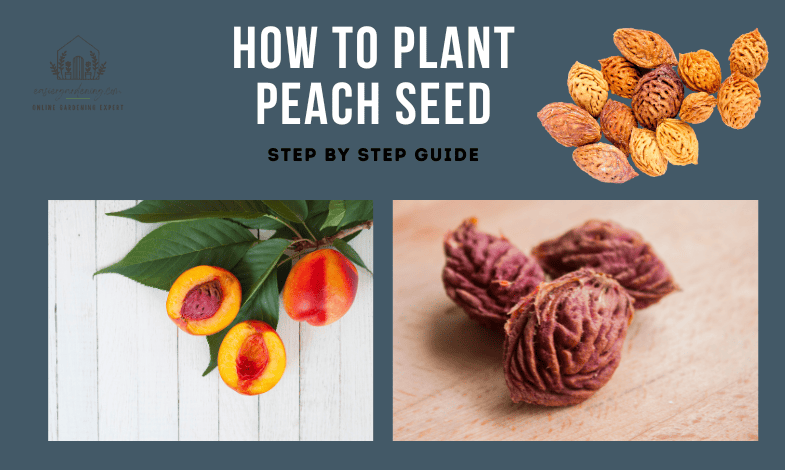Planting Peach Seed – How to Do It: Juicy sweet peaches! Stone fruit in general, be it plums, nectarines, or apricots – have already tempted many a thoroughgoing stone fruit lover to take the peach seed planting experiment into their own hands. But how to grow peach trees from seeds? When planting peach seeds, there are a few basic things to keep in mind. There are also one or two methodological tricks when it comes to the sowing itself. This will significantly improve the chances of success of such a project. In the following article, you will learn how to plant a peach seed in detail.
Read more about When to plant grass seed in spring?
Contents
- Planting the peach seed – what can you expect?
- Seedlings: Genetic component
- Seedlings: Environmental component
- Stone Fruit Sowing: The matter of dormancy
- Planting Peach Seed: How to overcome dormancy
- Final Thoughts: How to Plant Peach Seed?
- How long does it take for a peach seed to sprout?
- Can you grow a peach tree indoors?
- Are peach trees easy to grow?
Planting the peach seed – what can you expect?
Planting peach seed is not a child’s game. You should know what to expect. Especially if you do not harbor the appropriate stone fruit in your garden kingdom, it will be a disaster. After all, seed formation is the natural propagation strategy of plants. Peaches are completely self-fertile, plums and damsons at least partially. Self-fertility is also the reason why only one variety of most stone fruits can be planted and still set fruit. The plant fertilizes itself. In contrast, with some fruits such as apples and pears, there must always be at least two varieties within the pollinator range. The individual varieties cannot pollinate themselves; they are exclusively cross-pollinated.
Seedlings: Genetic component
Theoretically, if the seedling is self-fertile, it should have the same genetics as the parent plant. The fruit of the seedling should have the same characteristics as the fruit from which the seed was obtained. In the case of traditional stone fruit varieties, such as the so-called vineyard peaches, this has actually been done for generations. Self-fertilization and cross-fertilization with genetically very close individuals (usually even siblings) have led to the development of regional landraces.
However, modern breeding, on which the vast majority of stone fruit varieties cultivated today are based, exclusively produces heterozygous varieties. Heterozygous means that there are two different variants per gene. Self-pollination of heterozygous varieties then results in the splitting of genetic traits. Due to sophisticated vegetative grafting techniques, breeding is also no longer dependent on the seedling propagation of varieties at all.
Remember: self-fertilization only yields genetically identical offspring if the parent is homozygous. Stone fruit is generally heterozygous. Consequently, genetic splitting occurs among the offspring. The seedling fruit will most likely no longer have the same characteristics as the fruit from which the seed was obtained. Ultimately, this is the same issue as with tomato seed collection.
Seedlings: Environmental component
Now, you may think of just taking a seed from the supermarket; thanks to the genetic uniformity in commercial cultivation, the probability of self-fertilization is higher there. In principle, this is probably correct. But the catch with supermarket stone fruit is different. As the packaging label hopefully indicates, supermarket stone fruit usually comes from southern Europe. The varieties grown there are, on the one hand, adapted to the local climatic conditions and, on the other hand, to commercial cultivation. Both are not exactly optimal conditions to thrive in colder, wetter conditions and with less use of pesticides.
Note: It is highly recommended to use site-adapted mother varieties for stone fruit sowing.
Stone Fruit Sowing: The matter of dormancy
Seedling fruit, then, is unlikely to have the same characteristics as the fruit from which it is derived. If you don’t want to get into an experiment, you’re clearly better off with a grafted plant. However, if you get involved in sowing out of curiosity or breeding interest, you will very quickly be confronted with another characteristic of stone fruit. That brings with it a certain potential for horticultural frustration. The pronounced seed dormancy.
This natural mechanism is intended to protect the seeds from germinating at an inopportune time and is basically a delay in development. Thus, nothing at all happens if you press a “stone” into the ground, although there is still beautiful summer weather. Dormancy prevents the seed from germinating immediately. But in the remaining days of summer, it only grows into a half-strong plantlet that has no chance of surviving the winter. It ensures that the seedling will not begin to grow until the following growing season. But it will be able to take full advantage of it, and therefore more likely to survive the next winter.
Planting Peach Seed: How to overcome dormancy
When you are here to know how to plant a peach seed, you have to know how to overcome dormancy. Dormancy is broken by exposure to cold. After the winter, it should start right away. The simplest method is then to let the sown “peach stone” overwinter in a pot or directly in the garden. That too, without any protection from the weather. Nature does it that way too. It works. It just takes time; some winters are not enough to break the dormancy.
There are now countless recommendations on how long, at what temperature, and humidity you should store the seeds in the refrigerator. You may also have some questions in mind, like, “How long should be a peach seed dry before planting.” However, you do not need to worry about these if you follow the following method:
- The process starts with knowing how to crack open a peach seed. Continue by cracking the “stones.” The “stone” itself is not the actual seed; it is merely a woody fruit shell that must be cracked to get to the seed. The seed looks very familiar; it strongly reminds me of an almond (yes, it is also a drupe).
- The seeds are soaked in water for 1-2 hours, and then the brown seed coat is carefully pulled off. Care must be taken not to remove the spike at the end of the seed. In it is the root system, it is essential for germination. The final product, in turn, resembles something that can be found in the bakery assortment of any store: Shelled almonds.
- Sow the seed or plant the peach seed, cover the seed lightly with soil and water well. Make sure that the little point does not point upwards; from it grows the root. Otherwise, the seed will be forced into acrobatic contortions. It can also work but weakens growth.
- Water regularly, if necessary, keep free of weeds. Overwinter young plants frost-free (do not let them dry out!).
Read more about How and when to plant garlic?
Final Thoughts: How to Plant Peach Seed?
This method is based on removing the actual origin of dormancy with the seed coat. The seed coat is an important player. It decides on the water and gas supply of the embryo and prevents radicle growth as a mechanical barrier. It contains substances that inhibit the growth and development of the embryo.
Before you know how to plant a peach seed, you should have the mental preparation of being patient. Until the seedlings then bear fruit for the first time, usually pass another five or even more years. Impatient planting better-grafted seedlings, there the yield is already after 1-2 years. In this sense, all those who are curious and willing to experiment have a lot of patience when planting peach seeds!
Frequently Answered Question
How long does it take for a peach seed to sprout?
Depending on the variety of peach, it takes between one and three months for a peach seed to sprout.
Can you grow a peach tree indoors?
Although it might come as a surprise, yes, you can grow a peach tree indoors! However, it requires a different growing method.
Are peach trees easy to grow?
Growing a peach tree from seed for a long time and hard work. Approximately three to four years is necessary for the tree to start producing fruit. So for an easier and quicker solution, you can purchase a young tree from it and plant it in your home garden.



